Table of Contents
What are Battle Ropes?
Although it’s been associated with MMA training, the Battling Ropes System was created by John Brookfield, a strongman and trainer who practiced the rope training method in his backyard and went on to teach it to soldiers at a military base near him and with other athletes.
Since then, it has been adopted by MMA, Crossfit and other disciplines for conditioning purposes. Battle rope training burns a ton of calories and can be used in HIIT workouts.
A battle rope is a long, thick piece of rope that you grab the ends of and whip up and down to create waves in the rope, keeping up the momentum and changing the movement in a few different ways for variation. It’s a tough conditioning workout that requires just a piece of rope, making it perfect for minimalist gyms.
What Length Battle Rope Should I Get?
The rope is looped through an anchor point, so the amount of space you need to use a battle rope is half its length. For a 50ft rope, figure you’ll need 25ft of clear space. This provides enough space for your body too. After all, you aren’t pulling the rope taught. In fact, you will have to scoot up a few feet to create a large amount of slack in the rope to create the waves with.
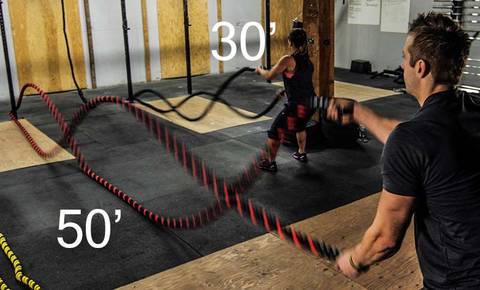
50ft is the most common length. I recommend you get that length if you have enough space.
40ft can work too, if you only have 20ft of space. Shorter or weaker athletes make full use of conditioning exercises with a 40 foot rope, while taller and stronger athletes will only lose a little.
A 30ft rope is maybe better than nothing. Only maybe. I only recommend getting a 30ft rope if you have no other option for your space and you’re dead set on getting a rope. Smaller people might do fine with it. It significantly cuts down on how well you can generate smooth, momentum-filled waves. You will feel the waves stop against the loop point of the rope right away, without the pleasing feeling you get from a longer rope. Remember that with a 30ft rope you’re standing about 12ft from the anchor. That gives you very little room for generating waves.
Battle Rope Thickness
Through sizing of things like olympic barbells and pull up bars, we know that 1″ to 1.5″ is about the thickness that human hands want to grip. Battle ropes are made 1.5″ thick to get them to the proper weight that creates enough momentum for battle rope training.
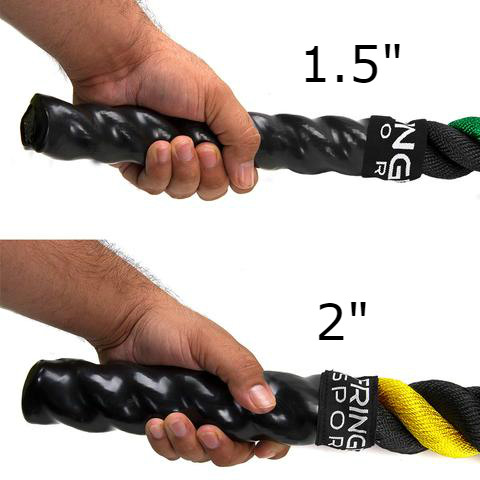
1.5″ is the standard thickness most people should use, man or woman, strong or weak. This is the thickness you’ll see in the majority of battle ropes for sale.
2″ ropes are a different animal. They are 33% heavier, turning the battle rope workout into more of a strength workout than a conditioning workout… Unless, of course, you’re a beast and you can handle it no problem.
Not only that, the thicker rope requires more grip strength, much like the “fat” olympic barbells out there made to challenge your grip.
Go with 1.5″ unless you’ve used ropes already and find 1.5″ too easy for your purposes.
Battle Rope Handles
The ends of the ropes are secured from unwinding with some type of thermoplastic material, otherwise known as heat-shrink, which means they are shrunk tightly onto the rope with a heat gun. They conveniently double as handles for you to grip more easily than you could grip the bare rope.
Here’s a unique handle I should point out…
Gronk Fitness makes this rope with knurled aluminum handles, the only one of its type I’ve ever seen other than on jump ropes. I think that’s where they got it from. As you can see, there are socket-head screws on the handle that make them uncomfortable to grip, negating what might be an otherwise appealing design. Maybe there’s some way to create a metal handle on the end of a rope with no screws set in it like this. A jump rope is so light that this isn’t a big deal, but you’re gripping these battle rope grips hard, and it should be comfortable.
Best Battle Rope Material
Manila
Good old fashioned manila rope is made from abaca plant leaves. Because it’s the only type of rope that is a natural fiber, it absorbs moisture from sweaty palms. That, combined with the fact that it has a rough texture, means it makes for the best grip.
Manila ropes are sometimes called “manila hemp” ropes. This is a misnomer. It’s not hemp at all. It’s fibrous like hemp, and people get confused. See further below for hemp ropes.
The downside to manila? The shedding. Oh man, the shedding. Your cat has nothing on this rope. Plan on regular sweeping.
That’s ok, you say, I’ll just use it outside.
Not where it’s wet, you won’t. Manila is a natural fiber and will rot if you give it a chance. This stuff all comes from the Philippines, where they have these banana trees called abaca, and the leaves are harvested for their fantastic fibers that seem to only be used in rope. It’s actually also used for a few other things like all-natural tea bags.
The other issue with manila is all natural fibers can eventually rot, especially if it is exposed to rain, because it absorbs moisture (and that’s why it gives you such a good grip – it absorbs the moisture from your hands). But realistically rotting can take years, and you’ll be able to tell when it’s looking questionable. Consider that manila ropes are still used for years at a time on boats. They are still in widespread use for a reason.
See the Rogue battle ropes. Their manila rope, – the only one they sell at the moment besides a very expensive sleeved rope – oddly enough doesn’t say the length. It’s 45 feet. I can tell by the weight, 26 lbs. A 50lb 1.5″ manila rope weighs about 28.5 lbs.
Poly Dacron and Other Polyester Ropes
Poly ropes usually are poly dacron, also called polydac, and some polypropylene mixed in. The mix varies between manufacturers. It’s a synthetic rope, and they’re all closer to each other than they are to manila.
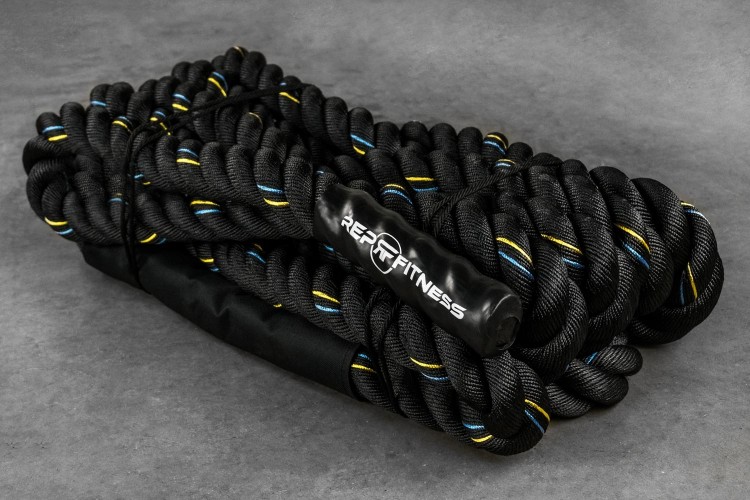
On the downside, technically it’s like 15% lighter than manila, making it easier. That shouldn’t really matter much for a conditioning workout. Only in strength workouts that involve a weight closer to your max, usually with barbell work, does the exact weight make much of a difference. Plus, some poly ropes have a heavy duty nylon sheath over them, adding to the weight to even things out.
Be warned that a good polydacron rope may also be too stiff when it arrives. Don’t return it. You have to give it a couple good workouts to loosen it up.
It doesn’t shed like manila does, which makes it a good conditioning rope. And it’s slightly lighter than manila so won’t give as heavy a workout for conditioning exercises, but the weight difference is only like 10%.
As a climbing rope, it’s more slippery than manila, partly because of the slick texture and partly because it doesn’t absorb moisture from your hands.
Although it doesn’t shed like manila, polydacron can still suffer fraying from abrasion. See the section further below about ropes that come in a protective sleeve.
Hemp
Hemp is here! Kind of.
This stuff was 100% banned in the US from 1937 to 2012. Only as of 2013 under some states’ legalization did some farms start growing it out in the open, betting against the federal government raiding them. In 2018, the Hemp Farming Act was passed and signed into law by President Trump, turning hemp into a completely legal agricultural commodity nationwide. So this is just starting, and you gotta give the farmers time to start experimenting with taking hemp to market and see how much demand for it there really is.
The ban was always silly, because this particular strain of cannabis plant is about as psychoactive as poppies (you’d need a lot), but you would need a good eye to tell the difference, which sealed hemp’s guilt-by-association fate as a controlled substance for 40 years. Ah well. At least we’re back to sanity.
Anyway, that history lesson aside…
I have bought some thin hemp rope, but as of yet, I have not seen any actual hemp battle ropes sold commercially, despite the “manila hemp” name you’ll see thrown around (it’s just advertisers trying to monetize the “hemp” keyword). Hemp battle ropes would be more supple, which is good, but perhaps even more prone to shedding, definitely more prone to rotting when wet, and possibly lighter? I’m doubtful it’s a good material for this purpose.
We’ll see what happens. If you see one, leave me a comment below and I’ll update this.
How to Anchor Battle Ropes
You can get away with just looping your rope around the upright of a power rack, or anything else that is handy inside or outside with low abrasion. People have looped them around small trees, steel poles, wood railings, anything. People have even looped the rope through a heavy kettlebell. There are endless battle rope anchor ideas if you’re in a pinch.
Longer term, you may want to see about using a proper anchor point made with a large eyelet. It helps not only with protecting the rope from the wear of sliding up and down against an uneven surface or edges, but also having the anchor of the rope about a foot off the ground to make the movement smoother and avoid having it pound the end of the rope so hard with every wave.
There are basically two types of rope anchor stations, both very simple: a steel eyelet anchor and a strap anchor.
Steel Eyelet Battle Rope Anchors
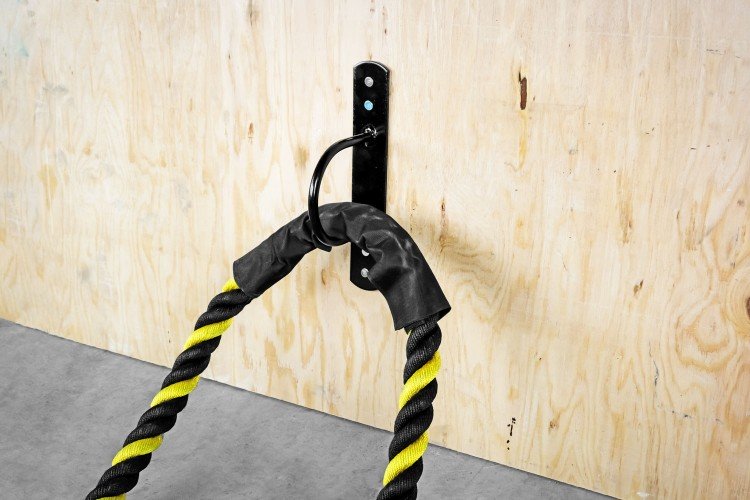
The $10 steel anchor from Rep Fitness needs to be drilled into a wall. That’s where I recommend you shop for the best quality battle ropes for the price, so you might as well pick up your anchor there if they have the type you want.
Rogue has rack-mounted steel anchors, particularly a model that is made to fit their Infinity, R-series, and Monster Lite racks, and another for those few of you who have a Monster rack.
You could fit one of those two models of Rogue anchors on a ton of other brands of racks and pick up some shorter bolts if needed. Just be aware of the hole size (5/8″ for the Monster Lite, 1″ for the Monster) and the fact that you want holes pretty low on the rack to mount to, about a foot off the ground.
Strap Anchor
For home use, or in a commercial environment where the rope is not moved and stored away, a strap anchor point is a reasonable option. The Rep Fitness $7 anchor strap you can easily mount on any piece of equipment and will help save your rope from fraying at the anchor point from abrasion as much as in a steel anchor ring.
Because of the way it’s mounted, hanging some distance from the fixed point, it gives your rope some extra room for free movement to help with the fluidity of your workout.
For commercial environments where the rope is stored away between workouts, the strap anchor will just cause frustration, like anything that can walk away, appear on the other side of the gym, or reappear a week later. Get the steel anchor. Gym managers long ago learned to have as few portable accessories lying around as possible.
Summary: Where to Buy and What to Get
Cheap battle ropes made of too much polypropylene are not worth it. Get a good one. Cheap ones feel stiff and don’t break in like a good rope with a high percentage of polydacron. Cheap manufacturers you’ve never heard of will go the cheapest route. They will also use the cheapest heat-shrink for the handles that might rip or stretch easily, letting your rope unravel.
I recommend you get a 50′ long, 1.5″ thick sleeved polydacron battle rope from Rep Fitness. Rep is the best place to buy battle ropes at the moment. Everyone who has bought this rope from Rep has been happy with it. All of Rep’s stuff is among the best quality. They don’t cut corners like some manufacturers. So these are among the best battle ropes for home use.
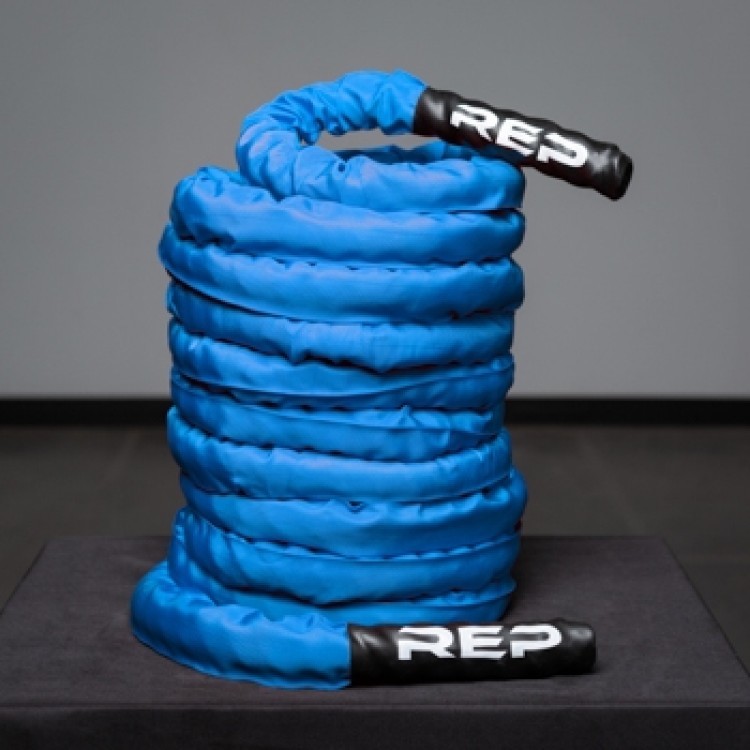
They used to offer a version of this rope without the big sleeve, and with only a 2ft short sleeve attached to the middle of the rope (scroll back to a pic further above) for wear protection against the anchor point. Finally they ditched that idea and now only selling ropes with the full sleeves.
They come in 3 colors and every size you could want: 1.5″ or 2″ handles, lengths of 30′, 40′ or 50′.
For anchor points, as discussed in full detail in a section above, you have the option of a Rep’s wall-mounted steel anchor, Rep’s budget-friendly $7 strap anchor, or Rogue’s rack-mounted steel anchor.
Once you’ve got the right rope ordered, see this article on Vice that’s the best I’ve seen on good form: Most people in the gym don’t know how to use battle ropes.

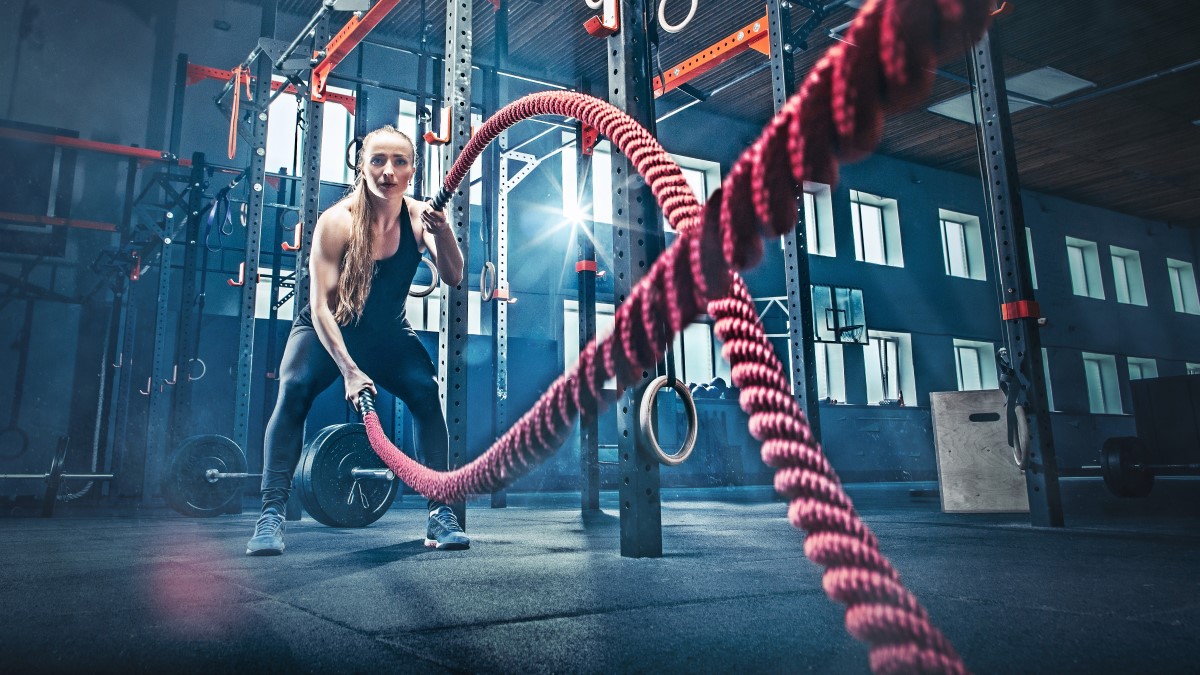
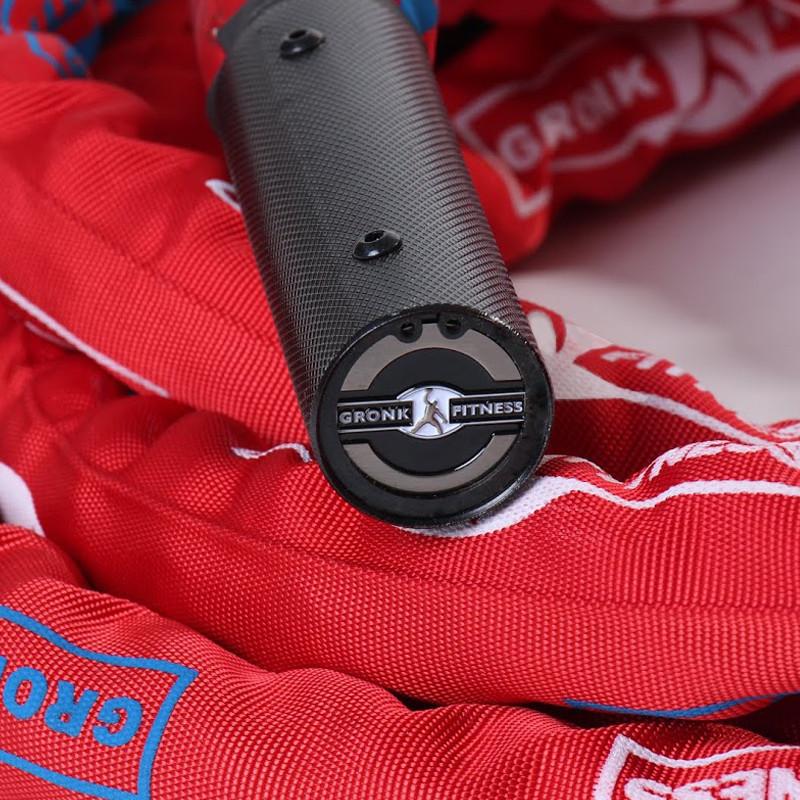
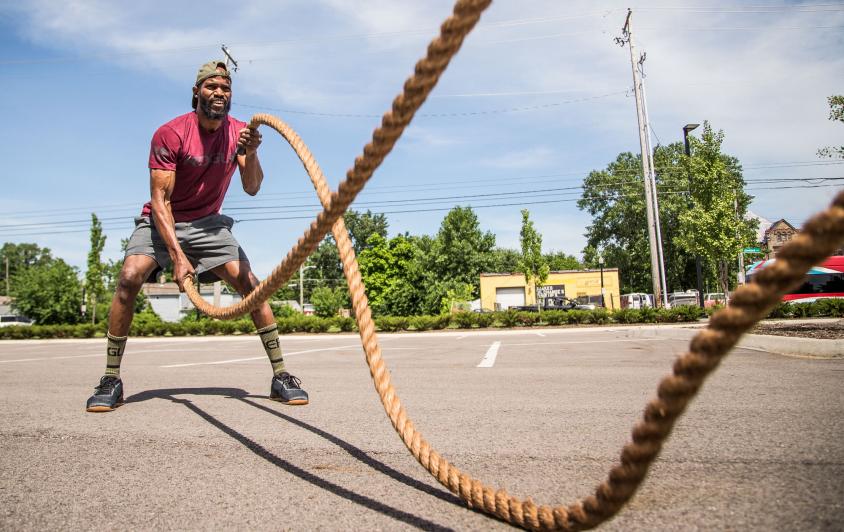
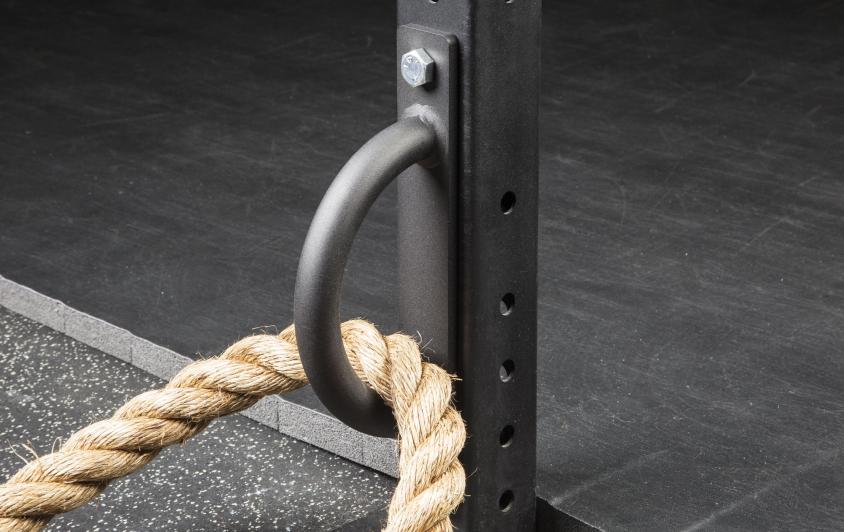
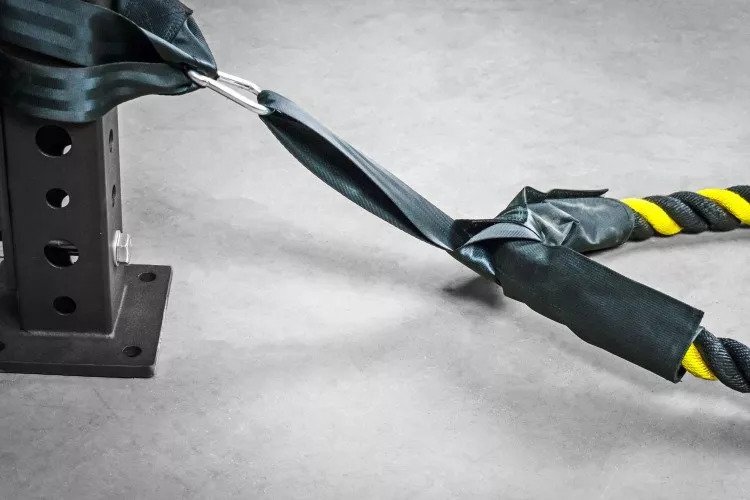
I’m having a house built with an exercise room. Unfortunately the length of the room is about 17 feet which is obviously not near enough for a 50′ rope. Is it possible to use a 40′ rope in 17′ of room length? My only other option is an outdoor (cold in winter) concrete covered patio that is 33′ long which would accommodate a 50′ rope. How much width does one need to rope exercise? Thanks
Possibly, given the curve at one of the rope and the slack. But you need room for your body too. I imagine a 40′ rope will require nearly 20′ of space.
So that leaves me with the 30′ option OR an outside set up fo 50 footer on the patio. My guess is you’d opt for the longer rope used on the patio?
Hey David! Thanks for all the info. I’m 6’2, 187pounds, little experience with ropes (some days in CrossFit) Im thinking to buy 40’ by 2” (because of my height I don’t know if the thickness matter) does this make sense or which rope do you recommend?
40′ is fine. 2″ is too much to start with. Get a 1.5″.
Thank you for the recommendation! Just one more question… I want to build muscle. With the 1.5” would I achieve it?
Ropes are meant more for conditioning. It’s possible to build some muscle with ropes under certain conditions. The most effective approach for building muscle is with increasing resistance over time as you adapt, done with a high enough intensity. That’s why people focus on lifting weights, where they can easily add more resistance.
Dam all the info I needed. Thank you David for being so in-depth about ropes. You think if I have to go shorter for sapce like 40′ but get a thicker 2″ it will make up for it?
A 2″ rope will require more power from you. 40′ isn’t a bad length. I’d recommend first trying the 1.5″ x 40′ rope if you aren’t experienced with them.